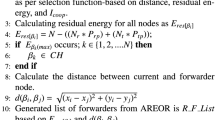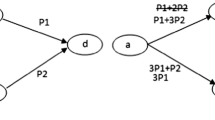Abstract
Adaptive ranking in opportunistic routings is known to significantly improve the performance over traditional opportunistic routing protocols in wireless networks using a volunteer node for energy efficiency. Wireless Sensor Networks (WSNs) mainly forward packets through neighbor nodes, which usually may go to sleep mode (when not in use) to improve the lifetime of the network. The sleep state of nodes is an infeasible mechanism because the nodes are awake continuously and are able to overhear other broadcasts. This paper presents a recently researched improved mechanism to determine the Cluster Head(CH) and set of nodes participating in routing. Node ranking resulted in the improved routing table for node selection to forward the packets towards the gateway was generated. By consistent performance modeling and network simulations, ARIOR algorithm exhibits improvements in terms of Message Success Rate(MSR), Packet Delivery Ratio(PDR) and Energy Consumption(CE) in comparison to existing Opportunistic Routing(OR) protocols.










Similar content being viewed by others
References
Biswas, S., & Morris, R. (2005). ExOR: Opportunistic multi-hop routing for wireless networks. ACM SIGCOMM Computer Communication Review, 35(4), 133–44.
Chachulski, S., Jennings, M., Katti, S., & Katabi, D. (2007). Trading structure for randomness in wireless opportunistic routing. ACM, 4(5), 67–82.
Larsson, P. (2001). Selection diversity forwarding in a multihop packet radio network with fading channel and capture. ACM SIGMOBILE Mobile Computing and Communications Review, 5(4), 47–54.
Choudhury, R. R., & Vaidya, N. H. (2004). MAC-layer anycasting in ad hoc networks. ACM SIGCOMM Computer Communication Review, 34(1), 75–80.
Pimentel, L., Rosário, D., Seruffo, M., Zhao, Z., & Braun, T. (2015). Adaptive beaconless opportunistic routing for multimedia distribution. In Proceedings of International Conference on Wired/Wireless Internet Communication (pp. 122–135).
Coutinho, R. W., Boukerche, A., Vieira, L. F., & Loureiro, A. A. (2014). GEDAR: Geographic and opportunistic routing protocol with depth adjustment for mobile underwater sensor networks. In Proceedings of IEEE International Conference on Communications (ICC) (pp. 251–256).
Wei, C., Zhi, C., Fan, P., & Letaief, K. B. (2009). AsOR: An energy efficient multi-hop opportunistic routing protocol for wireless sensor networks over Rayleigh fading channels. IEEE Transactions on Wireless Communications, 8(5), 2452–2463.
Amdouni, I., Adjih, C., Aitsaadi, N., & Muhlethaler, P. (2016) Experiments with ODYSSE: Opportunistic Duty cYcle based routing for wirelesS Sensor nEtworks. In Proceedings of IEEE 41st Conference on Local Computer Networks (LCN) (pp. 232–235).
Hai, L., Wang, H., Wang, J., & Tang, Z. (2014). HCOR: A high-throughput coding-aware opportunistic routing for inter-flow network coding in wireless mesh networks. EURASIP Journal on Wireless Communications and Networking, 20(14), 148–161.
De Couto, D. S., Aguayo, D., Bicket, J., & Morris, R. (2005). A high-throughput path metric for multi-hop wireless routing. Wireless Networks, 11(4), 419–34.
Tiwari, R., & Kumar, N. (2015). Cooperative gateway cache invalidation scheme for internet-based vehicular ad hoc networks. Wireless Personal Communications, 85, 1789–1814.
Tiwari, R., & Kumar, N. (2016). An adaptive cache invalidation technique for wireless environments. Telecommunication Systems, 62, 149–165.
Tiwari, R., & Kumar, N. (2015). Minimizing query delay using cooperation in ivanet. Procedia Computer Science, 57, 84–90.
Chithaluru, Premkumar, Tiwari, Rajeev, & Kumar, Kamal. (2019). Performance analysis of energy efficient opportunistic routing protocols in wireless sensor network. International Journal of Sensors, Wireless Communications and Control, 9, 1. https://doi.org/10.2174/2210327909666191026092311.
Tiwari, R. (2010). Gulista khan, “Load Balancing through distributed Web Caching with clusters”. In Proceeding of the CSNA, 46–54.
Krishan, T., Alkhawaldeh, R. S., Khawaldeh, S., Al-Ahmad, B., & Al, Smadi A. (2010). Hn-PERP: Hop by hop-power-efficient routing protocol over underwater wireless sensor networks. ACM, 9(8), 78–98.
Eu, Z. A., & Tan, H. P. (2012). Adaptive opportunistic routing protocol for energy harvesting wireless sensor networks. In Proceedings of IEEE international conference on communications (ICC) (pp. 318–322).
Lukošius, A. (2007). Opportunistic routing in multi-sink mobile ad hoc wireless sensor networks. University of Bremen publishers, pp. 1–296.
Mounika, M., & Chinnaswamy, C. N. (2016). Opportunistic routing protocols for wireless sensor networks: A survey. International Journal of Computer Science and Information Technologies, 7(2), 928–931.
Menon, V. G., & Prathap, P. J. (2016). Comparative analysis of opportunistic routing protocols for underwater acoustic sensor networks. In Proceedings of International Conference on Emerging Technological Trends (ICETT) (pp. 1–5).
Sharma, M., Singh, Y., & Kumar, N. (2014). Opportunistic routing in wireless sensor networks: A comparative analysis. Journal of Basic Applied Engineering Research (pp. 94–98).
Al-Mahdi, H., & Fouad, Y. (2019). Design and analysis of routing protocol for cognitive radio ad hoc networks in heterogeneous environment. International Journal of Electrical and Computer Engineering (IJECE), 9(1), 341–351.
Chithaluru, Premkumar, Tiwari, Rajeev, & Kumar, Kamal. (2019). AREOR-Adaptive ranking based energy efficient opportunistic routing scheme in Wireless Sensor Network. Computer Networks, 162, 106863.
Shah, R. C., Wietholter, S., Wolisz, A., & Rabaey, J. M. (2005). When does opportunistic routing make sense? In Proceedings of IEEE international conference on pervasive computing and communications workshops (pp. 350–356).
Ge, Y., Wang, S., & Ma, J. (2018). Optimization on TEEN routing protocol in cognitive wireless sensor network. EURASIP Journal on Wireless Communications and Networking (pp. 1–27).
Sanchez-Iborra, R., & Cano, M. D. (2016). JOKER: A novel opportunistic routing protocol. IEEE Journal on Selected Areas in Communications, 34(5), 1690–1703.
Islam, J., & Singh, P. K., (2010). CORMEN: Coding-aware opportunistic routing in wireless mess network, arXiv preprint, pp. 1006–1045.
Ghadimi, E., Landsiedel, O., Soldati, P., & Johansson, M. (2012). A metric for opportunistic routing in duty cycled wireless sensor networks. In Proceedings of 9th Annual IEEE Communications Society Conference on Sensor, Mesh and Ad Hoc Communications and Networks (SECON) (pp. 335–343).
Zeng, K., Yang, Z., & Lou, W. (2010). Opportunistic routing in multi-radio multi-channel multi-hop wireless networks. IEEE Transactions on Wireless Communications, 9(11), 3512–21.
Yan, Y., Zhang, B., Zheng, J., & Ma, J. (2010). Core: a coding-aware opportunistic routing mechanism for wireless mesh networks. IEEE Wireless Communications, 17(3), 96–103.
Poonkuzhali, R., Sanavullah, M. Y., & Gurupriya, M. R. (2014). A comparative study of novel opportunistic routing protocols in mobile ad hoc networks. World Academy of Science, Engineering and Technology, International Journal of Computer, Electrical, Automation, Control and Information Engineering, 8(8), 1529–1532.
Mao, X., Tang, S., Xu, X., Li, X. Y., & Ma, H. (2011). iLight: Indoor device-free passive tracking using wireless sensor networks. In Proceedings of IEEE INFOCOM (pp. 281–285).
Spachos, P., Chatzimisios, P., & Hatzinakos, D. (2012). Energy aware opportunistic routing in wireless sensor networks. In Proceedings of IEEE Globecom Workshops (pp. 405–409).
Hung, C. C., Lin, K. C., Hsu, C. C., Chou, C. F., & Tu, C. J. (2010). On enhancing network-lifetime using opportunistic routing in wireless sensor networks. In Proceedings of 19th International Conference on Computer Communications and Networks (pp. 1–6).
Luo, J., Hu, J., Wu, D., & Li, R. (2014). Opportunistic routing algorithm for relay node selection in wireless sensor networks. IEEE Transactions on Industrial Informatics, 11(1), 112–121.
Hsu, C. C., Kuo, M. S., Wang, S. C., & Chou, C. F. (2012). Joint design of asynchronous sleep-wake scheduling and opportunistic routing in wireless sensor networks. IEEE Transactions on Computers, 63(7), 1840–1846.
Author information
Authors and Affiliations
Corresponding author
Additional information
Publisher's Note
Springer Nature remains neutral with regard to jurisdictional claims in published maps and institutional affiliations.
Rights and permissions
About this article
Cite this article
Chithaluru, P., Tiwari, R. & Kumar, K. ARIOR: Adaptive Ranking Based Improved Opportunistic Routing in Wireless Sensor Networks. Wireless Pers Commun 116, 153–176 (2021). https://doi.org/10.1007/s11277-020-07709-0
Published:
Issue Date:
DOI: https://doi.org/10.1007/s11277-020-07709-0




